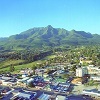GEORGE NEWS - In a recent article the Southern Cape Landowners Initiative (SCLI) expressed concern over the state of the Touw River.
It said the river has become significantly shallower over the past two decades and the river channels narrower with ever more reeds encroaching, and seemingly permanent islands forming. In response to this, SANParks issued the following statement:
The Touw River Estuary is classified as temporarily open / closed estuary. Unlike the Knysna Estuary that is permanently open to sea, the Touw River Estuary has an open phase when the estuary is open to the sea and a closed phase when it is closed off from the sea. Neither phase is better or bad, they are just ecologically different.
• The Touw River Estuary includes Island Lake, Langvlei, Rondevlei and the narrow interleading channels between these three water bodies and constitutes the entire system. The management of the Touw River mouth, which includes mechanical breaching, is done according to prescribed management practices contained in the Garden Route National Park Management Plan approved by the National Department of Environment, Forestry and Fisheries.
• The prescribed height for mechanical breaching is between 2,1 and 2,4 metres above mean sea level. Automated rain gauges, river water level gauges and sand berm heights are measured and are part of the structured process that informs decision making on when to mechanically breach the estuary mouth.
The mechanical breaching is required to protect low-lying property developments in the natural flood plain of the estuary. The heights were calculated to minimise flooding risk to properties while still ensuring sufficient pressure to scour sediments from the estuary.
• Automated rain gauges in the mountain catchments provide an early warning system to guide proactive decision-making.
• The proactive management of sandbar heights and preparation channels are also measures aimed at minimising the time needed to breach the estuary mouth should unexpected heavy rainfall events occur.
• Long-term monitoring and research programmes that date back to the 1970s provide an important understanding of the ecological functioning as well as the tracking of long-term trends. Management plans and actions are informed by this information. The dredging of sediment from road culverts was one such management action that was implemented.
Below are some key projects that are ongoing:
- Long-term changes in emergent vegetation in Wilderness lakes
- Monitoring water quality and water bird abundance in the lakes, rivers and estuaries of the Wilderness National Park
- Long-term lake sedimentation study in the Garden Route National Park Wilderness Coastal Section (GRNP-WCS)
- Standing biomass of submerged aquatic plants on the littoral zone of the saline waterbodies of the Wilderness NP
- Fish population monitoring
- Mechanical and natural breaching events as well as mouth closure
In good condition
The data from the long-term monitoring programmes and other research indicates that the estuary is not heavily degraded but in a good condition. Sedimentation in an estuary is a natural process, although the sand build-up near the estuary mouth is more due to sand ingress from the sea and can probably be linked to the construction of the N2 bridge and railway line.
Climate change modelling for Garden Route suggests that the area will experience an increase in coastal storms and more intense rainfall events that may likely increase the risk of flooding.
SANParks supports the clearing of invasive alien plants in the Touw River catchment area, as the supply of a good volume of water as well as water of good quality are main ecological drivers of ensuring estuary health.
'We bring you the latest George, Garden Route news'
















